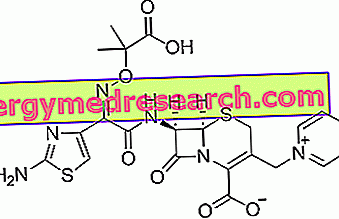Ceftazidime is a beta-lactam type antibiotic belonging to the third generation cephalosporin class.

Ceftazidime - Chemical Structure
Ceftazidime has a fairly broad spectrum of action; it is in fact endowed with a greater activity towards Gram-negative bacteria compared to first and second generation cephalosporins. In addition, it also has good activity against Gram-positive bacteria, unlike other third-generation cephalosporins which are generally more effective in the treatment of Gram-negative infections.
Indications
For what it uses
Ceftazidime is used to treat infections caused by micro-organisms sensitive to ceftazidime itself.
In particular, the use of ceftazidime is indicated for the treatment of:
- Pulmonary or thoracic infections;
- Infections in the bronchi and lungs in patients with cystic fibrosis;
- Meningitis;
- Ear infections;
- Urinary tract infections;
- Skin and soft tissue infections;
- peritonitis;
- Osteoarticular infections.
Furthermore, ceftazidime can be used to treat patients with leukopenia who have fever triggered by a bacterial infection.
Finally, the drug is also used in the prophylaxis therapy of surgical infections.
Warnings
In case of allergic reactions to ceftazidime, treatment with the drug should be stopped immediately.
Ceftazidime can cause false positives in the Coombs test and in the test that determines the amount of glucose in the urine.
Because of its instability, ceftazidime must be stored away from light.
Ceftazidime can cause side effects that can alter the ability to drive and use machines, so great care should be taken. Such activities should be avoided until you are sure that the drug does not cause the aforementioned side effects.
Interactions
Before starting ceftazidime therapy, you must tell your doctor if you are already taking any of the following medications:
- Chloramphenicol (an antibiotic);
- Aminoglycosides, another class of antibiotic drugs;
- Furosemide, a powerful diuretic drug.
In any case, it is necessary to inform your doctor if you are taking - or have recently taken - any type of medication, including over-the-counter products, herbal and / or homeopathic products.
Side effects
Ceftazidime can cause various types of side effects, although not all patients experience them. This depends on the sensitivity that each individual has towards the drug.
The main side effects that can occur during treatment with ceftazidime are listed below.
Allergic reactions
Ceftazidime can trigger allergic reactions, even serious ones, in sensitive individuals. The symptoms with which these reactions can occur are:
- Raised and itchy skin eruptions;
- Swelling of the face and mouth with consequent difficulty in breathing and difficulty swallowing.
Skin and subcutaneous tissue disorders
Treatment with ceftazidime can cause:
- Rashes with blister formation;
- Skin peeling;
- Stevens-Johnson syndrome;
- Toxic epidermal necrolysis.
Blood and lymphatic system disorders
Treatment with ceftazidime may cause:
- Increased number of platelets in the bloodstream;
- Eosinophilia, ie the increase in plasma concentration of eosinophils;
- Hemolytic anemia;
- Plateletopenia (ie the decrease in the number of platelets in the bloodstream), with consequent increased risk of bleeding;
- Leukopenia, ie the reduction in the number of leukocytes in the bloodstream.
Gastrointestinal disorders
Treatment with ceftazidime can cause nausea, vomiting, diarrhea, stomach pain and inflammation of the large intestine accompanied by pain and diarrhea that may contain blood.
Nervous system disorders
Treatment with ceftazidime can cause headaches and dizziness.
Infections
Treatment with ceftazidime can promote the onset of fungal infections, such as candidiasis in the mouth (thrush) and vagina.
Other side effects
Other side effects that may occur during ceftazidime therapy are:
- Fever and chills;
- Inflammation or kidney failure;
- Increased hepatic transaminases in the bloodstream;
- Jaundice;
- Increased blood concentrations of non-protein nitrogen (increased azotemia), creatinine (increased creatinemia) and urea;
- Alterations in the sense of taste;
- Pain, burning, swelling or inflammation at the injection site.
Overdose
If you suspect you have taken an overdose of ceftazidime, you must tell your doctor immediately.
Action mechanism
Ceftazidime exerts its bactericidal antibiotic action (ie it is able to kill bacteria) interfering with the synthesis of the bacterial cell wall, the peptidoglycan.
Peptidoglycan is a polymer made up of parallel chains of nitrogenated carbohydrates, joined together by transverse bonds between amino acid residues. These bonds are formed thanks to the action of a particular enzyme, transammidase.
Ceftazidime binds to transammidase preventing the formation of the aforementioned bonds. In this way, weak areas are generated within the peptidoglycan that lead to the lysis of the bacterial cell and, consequently, to its death.
Mode of Use - Posology
Ceftazidime is available for intramuscular and intravenous administration. It is in the form of a powder that must be dissolved in a suitable solvent just before its use.
Ceftazidime is administered by a doctor or nurse by intravenous infusion, or by direct injection into a vein or into a muscle.
The dosage of ceftazidime is established by the doctor on an individual basis, depending on the type and severity of the infection to be treated and on the age, body weight and health conditions of each patient.
Following are some indications on the doses of drug that are usually used.
Adults and adolescents with a body weight of 40 kg or more
The dose of ceftazidime usually administered is 1-2 g, to be taken three times a day. The maximum daily dose of 9 g of drug should never be exceeded.
Children with at least two months of life and children with a body weight of less than 40 kg
The dose of ceftazidime that is usually used is 100-150 mg / kg of body weight per day, divided into three equal doses.
The maximum daily dose that should not be exceeded is 6 g of drug per day.
Infants from 0 to 2 months of age
The amount of ceftazidime usually administered is 25-60 mg / kg of body weight per day, to be divided into two equal doses.
Seniors over 65 years of age
The daily dose of ceftazidime should not exceed 3 g per day, particularly in patients over 80 years of age.
Patients with kidney disease
In this category of patients, the doctor may decide to reduce the dose of ceftazidime usually used. The dose of drug administered varies depending on the severity of the renal disease.
Pregnancy and breastfeeding
The use of the drug by pregnant women or by breast-feeding mothers should be done only after a careful evaluation of the relationship between the expected benefits for the mother and the potential risks to the fetus or newborn.
In any case, before taking ceftazidime - or any other medication - it is essential to seek medical advice.
Contraindications
The use of ceftazidime is contraindicated in patients with known hypersensitivity to ceftazidime itself, to other cephalosporins or to other beta-lactam type antibiotics.



